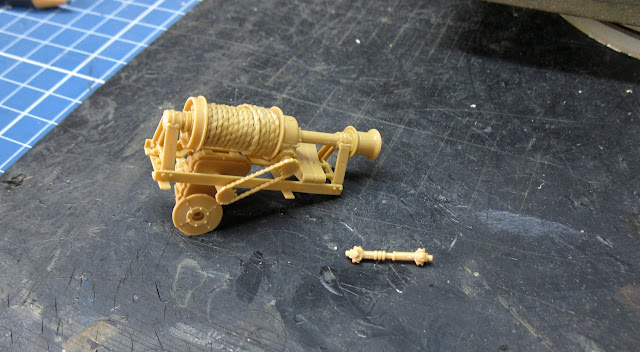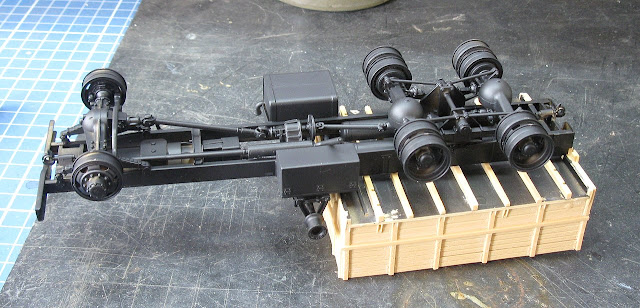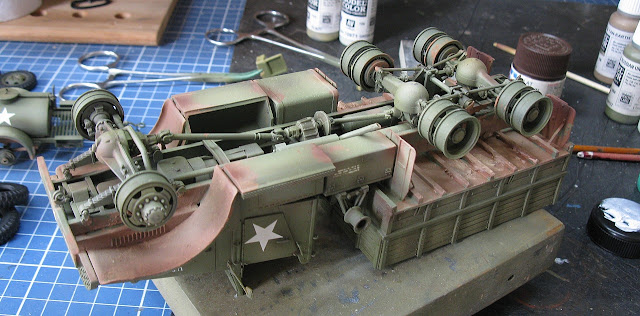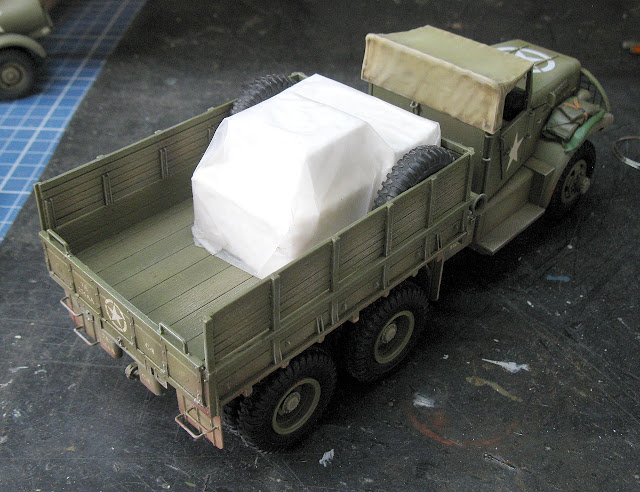Truck drivers!!!
Today we are going to meet a multi-tasking prime mover, who served with the Americans from 1941 until after WWII. Today, we will talk about the White 666 heavy truck (6-ton 6x6 truck).
 |
| A very well preserved White 666 heavy truck (6-ton 6x6 truck) font: Youtube |
The 6-ton 6×6 truck (supply catalog designations G512, 514, 526, and 547) was a family of heavy tactical trucks built for the United States Army during World War II. The basic cargo version was designed to transport a 6-short ton (5,400 kg) cargo load over all terrain in all weather. The chassis were built by Brockway Motor Company, The Corbitt Company, The Four Wheel Drive Auto Company (FWD), Ward LaFrance Truck Corporation, and White Motor Company. They were replaced by the M54 5-ton 6x6 trucks in the 1950s.
History
In 1939–1941 the Army Ordnance Corps was developing a complete line of tactical trucks that could operate over all roads and cross-country terrain in all weather. A 6-ton (5,400 kg) payload rated 6×6 truck to tow anti-aircraft artillery was needed. The Corbitt Company, a small company who had sold the US Army trucks since 1917, began delivering 200 prototypes in 1940.
 |
| Corbitt 3,5 ton. truck - U.S. Navy - 1920. |
In 1941 their improved Model 50SD6, with a larger engine and different hood and fenders, was standardized and went into production, but White Motor Company soon became their largest producer. Brockway Motor Company began in 1942, and The Four Wheel Drive Auto Company (FWD) in 1945. Ward LaFrance also built the chassis. Seven body types were built, some by more than one manufacturer. All manufacturer's models were virtually identical, with very minor variations. Early models had closed cabs with full doors. In 1942 open cabs with half doors were introduced.
 |
| 6-ton 6x6 heavy truck - 1942 open cabin - cargo version - left view font: TM9-813 Technical manual |
 |
| 6-ton 6x6 heavy truck - 1942 open cabin - cargo version - rear right view font: TM9-813 Technical manual |
Specifications
Engine and driveline
All standardized models used Hercules HXD engines, a 14.000 cc (855 cu in) displacement L-head inline 6 cylinder gasoline engine, developing 202 hp (151 kW) at 2100 rpm and 642 lbf⋅ft (870 N⋅m) of torque at 900 rpm.
 |
| Hercules HXD petrol engine font: TM9-813 Technical manual |
A Fuller 4-speed manual non-synchronized transmission with a very low 1st and direct 4th gear was used. A Timken transfer case had a high and low range, a neutral for Power take-off (PTO) operation, and engaged the front axle. Rear axles were Timken double reduction “pumpkin” type; tractors had heavier rear axles.
 |
| White 666 heavy truck - front axle rear view font: TM9-813 Technical manual |
 |
| White 666 heavy truck - rear axles top view font: TM9-813 Technical manual |
Chassis
Most models had a ladder frame with three live axles, the front on leaf springs, the rear tandem leaf springs with locating arms. The exception was the crane truck, which had a walking beam rear suspension for stability.
 |
| White 666 heavy truck - chassis top rear view font: TM9-813 Technical manual |
There were three wheelbases. The short, used for prime movers, was 4.70 m; the long, used for cranes, was 5.00 m and the extra long, used for bridge erectors, was 5.59 m. Measurements are from the centerline of the front axle to the centerline of rear tandem.
Prime movers and tankers had 10.00×22 size tires, while bridge, crane, and semi-tractor trucks had 14.00×20s with a larger cross-section. All had dual rear tires. Brakes were full air with drum brakes on all wheels. Prime movers had adjustable electrical brake connections for trailer brakes.
The Prime movers had a 11,000 kg winch behind the cab, most other trucks had a front-mounted two-drum winch for self-recovery. Trucks converted from prime mover chassis had no winch at all.
Models
Prime mover cargo truck
Prime movers were used to tow field artillery pieces, they also transported gun crews, equipment, and ammunition. They had a pintle hitch at the rear for towing up to 18,000 kg. Another pintle at the front could be used to emplace the piece. A mid-mounted 11,000 kg winch had a centered cable drum and a capstan on the right side. Pulleys and rollers routed the cable under the body and out the rear frame cross-member.
With a short wheelbase, mid-mounted winch, and short overhang, the body could only be 2.74 m long. Both sides had sideboards with fold down troop seats and bows for a tarpaulin. Two spare tires were mounted inside the body, one along each side. Early models had all steel bodies, in 1942 they were replaced by largely wood types to conserve steel. All Corbitts (3,077) were prime movers, White also built 3,547.
 |
| 6-ton 6x6 heavy truck - 1942 closed cabin - cargo version National Museum of Military Vehicles Dubois - Wyoming - USA |
 |
| 6-ton 6x6 heavy truck - 1942 closed cabin - cargo version National Museum of Military Vehicles Dubois - Wyoming - USA pics via David Kettler (thanks a lot, man) |
 |
| 6-ton 6x6 heavy truck - 1942 closed cabin - cargo version National Museum of Military Vehicles Dubois - Wyoming - USA pics via David Kettler (thanks a lot, man) |
 |
| 6-ton 6x6 heavy truck - 1942 open cabin - cargo version National Museum of Military Vehicles Dubois - Wyoming - USA pics via David Kettler (thanks a lot, man) |
 |
| 6-ton 6x6 heavy truck - 1942 open cabin - cargo version National Museum of Military Vehicles Dubois - Wyoming - USA pics via David Kettler (thanks a lot, man) |
 |
| 6-ton 6x6 heavy truck - 1942 open cabin - cargo version National Museum of Military Vehicles Dubois - Wyoming - USA pics via David Kettler (thanks a lot, man) |
 |
| 6-ton 6x6 heavy truck - 1942 open cabin - cargo version National Museum of Military Vehicles Dubois - Wyoming - USA pics via David Kettler (thanks a lot, man) |
 |
| 6-ton 6x6 heavy truck - 1942 open cabin - cargo version National Museum of Military Vehicles Dubois - Wyoming - USA pics via David Kettler (thanks a lot, man) |
 |
| 6-ton 6x6 heavy truck - 1942 open cabin - cargo version National Museum of Military Vehicles Dubois - Wyoming - USA pics via David Kettler (thanks a lot, man) |
 |
| A preserved 6-ton 6x6 heavy truck - 1942 - open cab World War Two American Experience Museum Gettysburg, PA |
Bridge erection truck ("Treadway truck")
Built on a long, reinforced chassis, they were used to carry treadway pontoon bridges for Engineer Combat Battalions.
 |
| 6-ton 6x6 Bridge erection truck - closed cabin right front view font: TM9-813 Technical manual |
 |
| 6-ton 6x6 Bridge erection truck - closed cabin - closed cabin left rear view font: TM9-813 Technical manual |
A large double arm hydraulic boom built by Heil was used to self unload components, often directly into a river. A 11,000 kg winch was mounted at the front. They had an auxiliary air compressor and large reservoir tanks, used to inflate pontoon floats. Brockway built 1,166, White 1,152, Ward LaFrance 589, and FWD 168 units.
 |
| A preserved 6-ton 6x6 Bridge erection truck - open cabin left front view |
Crane truck
Quickway cranes were used by combat engineers to unload and assemble bridge components. The rotating crane was powered by an auxiliary IHC 5.5 liters inline 4 cylinder engine developing 35 hp (26 kW). As a derrick it could lift 5,900 kg at a minimum radius of 3.0 m and 2,520 kg at a maximum radius of 7.62 m. A shovel, clamshell, dragline, and drilling equipment could also be used.
 |
| 6-ton 6x6 heavy crane truck front right view font: TM9-813 Technical manual |
The cab had a windshield on the left side only, in transit the boom went over the right side and was braced to the front bumper. A 11,000 kg winch was mounted on the front. Brockway built 1,224.
 |
| 6-ton 6x6 heavy crane truck Notice the assimetrical open cabin, in the left side. rear left view font: TM9-813 Technical manual |
 |
| A preserved 6-ton 6x6 heavy crane truck front left view font: Univem Association |
Tractor truck
As artillery pieces were being towed more often by tracked vehicles, prime mover chassis became available for other uses. In 1945 White built 112 semi-tractors with a fifth wheel and heavier rated Timken axles. Tire size was 14.00×20. Maximum speed was 64 km/h, the highest in the series. A 11,000 kg winch was mounted on the front.
 |
| 6-ton 6x6 heavy tractor truck rear right view |
 |
| 6-ton 6x6 heavy tractor truck front right view - Notice the winch in the front chassis font: TM9-813 Technical manual |
Gasoline tank truck
Wanting a fuel tanker larger than the CCKW, the Army ordered 25 from White. The body had 4 self-sealing tank compartments for a total of 7,600 liters. A bow and canvas top was fitted, so the truck could be disguised as a common cargo truck. Early trucks had a hard cab and a front-mounted pintle hitch, later trucks had an open cab and a 11,000 kg front winch. A 7,600 liters trailer could be towed. No follow up orders were made.
 |
| 6-ton 6x6 heavy gasoline tank truck front right view - closed cab - early version font: TM9-813 Technical manual |
Fire crash truck
Fire Crash trucks were used by the US Army Air Force to fight fires from airplane crashes. Brockway and Ward LaFrance chassis were equipped with bodies by Mack and American LaFrance (a separate company), both had auxiliary engines for the pump. This allowed the truck to move while two foam nozzles were being used. American LaFrance used their own 12 cylinder engine and 4 stage pump. Mack used a Continental R-6602 developing 225 hp (168 kW) to drive a Hale centrifugal pump capable of 1,230 liters/min) at 500 psi.
 |
| 6-ton 6x6 fire crash truck front left view - open cab |
 |
| 6-ton 6x6 fire crash truck front right view - open cab |
Prime mover van truck
White built communication vans for the Army Air Force on the prime mover wheelbase. Bodies were from Superior and Thomas. They were used to tow and power the SCR-545-A anti-aircraft radar set. White built 1,870.
 |
| 6-ton 6x6 prime mover van truck towing a trailer - front right view |
Dimensions
Model Manufacturer | Wheelbase | Length | Width | Height | Weight empty |
|---|---|---|---|---|---|
Prime Mover Corbitt | short | 7.24 m | 2.44 m | 3.00 m | 9,990 kg |
Bridge Brockway | extra long | 9.40 m | 2.54 m | 2.74 m | 12,000 kg |
Crane Brockway | long | 10.57 m | 2.54 m | 3.45 m | 16,000 kg |
Tractor White | short | 7.09 m | 2.57 m | 2.87 m | 10,010 kg |
Tank White | short | 7.26 m | 2.49 m | 2.44 m | 10,800 kg |
Fire Crash Brockway | long | 9.02 m | 2.64 m | 3.81 m | 14,200 kg |
Van White | short | 7.32 m | 2.44 m | 3.18 m | 9,600 kg |
| White 6-ton 6×6 Truck | |
|---|---|
| Type | 6-ton 6×6 truck |
| Place of origin | United States |
| Production history | |
| Designer | Corbitt |
| Manufacturer | Brockway, Corbitt, FWD, Ward LaFrance, White |
| Produced | 1941–1945 |
| No. built | 219,882 |
| Specifications (Prime mover) | |
| Mass | 10,400 kg - empty |
| Length | 7.24 m |
| Width | 2.44 m |
| Height | 2.90 - 3,00 m |
| Engine | Hercules HXD 202 hp (151 kW) |
| Transmission | 4 speed × 2 range |
| Suspension | Live beam axles on leaf springs |
Operational range | 322 km |
| Maximum speed | 60 km/h |
The kit:
For this project, the option is the kit (2014) US White 666 Cargo - Soft Top, from HobbyBoss (# 83802).
 |
| US White 666 Cargo - Soft Top HobbyBoss kit (# 83802) box art |
 |
| The Hobby Boss kit in my workbench, in good company... |
 |
| Starting by the chassis... Detail: The engine is not included in the kit... only its lower part... Notice how big the truck is... |
 |
| Building the winch installed "midships" of the truck |
To reproduce the steel rope, the Hobby Boss kit provides a 0.6mm thick cable, but this wire is very "hairy". I decided to replace this detail with a waxed cable, completely "bald" (like Kojak...), to be as realistic as possible.
 |
| The new steel rope installed in the winch. Much better... Notice the chassis growing in background... |
 |
| The new steel rope, in close view |
 |
| The winch, ready...and its drive shaft... The kit is very well detailed... |
 |
| The chassis with the winch. left view |
 |
| The chassis with the winch. left view |
 |
| The two rear differential gear boxes |
 |
| Rear wheels and hubs |
 |
| Installing the rear wheels and hubs onto the rear suspension bogies and the front axle, too... |
 |
| Here, alignment and perpendicularity are essential... |
 |
| The chassis, perfectly supported by its suspensions and wheels. left view |
 |
| The chassis, perfectly supported by its suspensions and wheels. right view |
 |
| The chassis, suspensions, drive shafts and wheels. belly view |
 |
| Installing metal plates (PE) on the truck's side step racks. The use of super glue and clamps is mandatory here... |
After completing the chassis, I decided to paint it with a layer of primer, to facilitate the future application of paint (olive-drab). I didn't take pictures of this stage (sorry...)
 |
| Building and testing the positioning of the cargo area, at the rear of the chassis, in dry-run. |
 |
| The alignment remains excellent... |
 |
| Installing the front fenders, as well as the side steps and their tool boxes. left view |
 |
| Installing the front fenders, as well as the side steps and their tool boxes. right view |
 |
| Building the open cabin. The front grill is in dry-run, to test the fittings (which are perfect...) |
 |
| Open cabin - rear view |
 |
| The cabin, glued in his position. |
 |
| The cabin, glued in his position with front grill installed and glued into position. |
Well... let's start the painting... To make things easier, let's make a marking and painting guide. I'll use the 7th Army version of the model: White 666 prime mover truck, serving with the 7th American Army , in the 236th Antiaircraft Artillery Searchlight Battalion (Battery C, truck number 8), during the Battle for Siegfried Line, in Germany, in early 1945.
These markings are available on the HobbyBoss decal sheet, although without any mention of their position or details about them... It was a bit complicated to track down their historical references...
 |
| HobbyBoss decal sheet. Markings that will be used in red |
But, first of all, olive drab in our girl:
 |
| Painting in Olive Drab...first layers of colors and tones. front right view |
 |
| Painting in Olive Drab...first layers of colors and tones. rear left view |
 |
| Testing the canvas of open cabin... Dry run, to test the fittings... |
 |
| Canvas test - front left view Dry run, to test the fittings... |
 |
| Working with olive drab tones, before applying the decals... |
After applying the decals, I decided to add some roll bags from Value Gear Details to give the vehicle more realism. A truck without cargo is like a pizza without mozzarella, capisce? My idea is to fit some roll bags over the front fenders, which act as natural platforms for these devices. The problem is that the surfaces are curved and the Value Gear resin parts are flat. But there is a way to make this work:
 |
| Roll bags curved in the fender and flat in the rear platform... How to do this??? |
It's as easy as slapping a drunk:...just dip the resin piece in a bowl of boiling water, wait about 1 minute (until the resin softens...) and, with your fingers (be careful not to burn yourself...), bend the piece with the strength of your hand or force the piece onto a cylindrical surface, to simulate the desired curvature. Hold this curvature for a few seconds, until it cools and stabilizes in this shape (or ask someone to pour cold water over the piece, while you maintain the desired curvature...). It may seem complicated, but it's extremely simple. See the infographic below:
 |
| How to fold roll bags using hot water... |
And here are the results obtained:
 |
| Value Gear stuff: curved for the fenders flat for the winch platform... |
 |
| Testing...testing in the left front fender: PERFECT!! |
 |
| In the right fender, this little detail is is getting in the way a bit. Either we remove the detail or we make an adaptation to the roll bag... |
 |
| I decided to keep the detail on the mudguard and hollow out the resin piece: Dremel with rotary cutting tool... |
 |
Now yes: perfect adaptation!! Happy!! Now let's paint these details separately... |
Continuing the build: Let's remove the nasty weld lines from the vinyl tire treads. I use a Dremel abrasive wheel to do this...
 |
| Tires completely "virgin" (red arrows) and worn, as would be correct for my representation of an operational vehicle (blue)... |
 |
| Continuing with the wear and tear... |
But before installing the tires on the wheels, let's make a little mess, simulating mud splashed on the internal and lower portions of the truck...
 |
| A little dirt never hurt anyone... left view |
 |
| Right view |
 |
| Belly right view |
 |
| Belly left view |
 |
| Applying the decal in the dashboard, with a small wash to highlight... |
And talking about loads and talking about pizzas...
 |
| Let's load our truck with a very heavy load: the Styrofoam technique with tracing paper... |
 |
| Testing the dimensions of our cargo load... |
 |
| And bringing a little more spice to our pizza: MiniArt US fuel drums 55 gal. (208 liters) (#35592) |
 |
| The load fitted in its place, between the spare wheels left view |
 |
| The load fitted in its place, between the spare wheels right view. Notice the roll bag in the front fender... |
 |
| In addition to the tarpaulin-covered cargo, there is also space for four 55-US-gallon (208-liter) fuel drums. |
 |
| The tarpaulin-covered cargo, painted in khaki-drab and glued in his place,,, |
 |
| ...and the fuel drums, fitted to the rear of the tarpaulin load and tied with ropes to the side walls of the truck's cargo bed. left view |
 |
| The fuel drums, fitted to the rear of the tarpaulin load and tied with ropes to the side walls of the truck's cargo bed. right view |
And after a few discreet layers of dirt and aging, here is our girl totally ready for action. With you, White 666 heavy truck (6-ton 6x6 truck - open cabin) in the colors of 7th American Army, serving under the 236th Antiaircraft Artillery Searchlight Battalion (Battery C, truck number 8), during the Battle for Siegfried Line, in Germany, in early 1945.
 |
| White 666 heavy truck (6-ton 6x6 truck - open cabin) 7th American Army - 236th Antiaircraft Artillery Searchlight Battalion Battery C - truck number 8 Battle for Siegfried Line - Germany - early 1945. |
 |
| White 666 heavy truck (6-ton 6x6 truck - open cabin) left view |
 |
| White 666 heavy truck (6-ton 6x6 truck - open cabin) rear left view |
 |
| White 666 heavy truck (6-ton 6x6 truck - open cabin) rear right view |
 |
| White 666 heavy truck (6-ton 6x6 truck - open cabin) rear left top view |
 |
| White 666 heavy truck (6-ton 6x6 truck - open cabin) right view |
 |
| White 666 heavy truck (6-ton 6x6 truck - open cabin) right front view |
 |
| White 666 heavy truck (6-ton 6x6 truck - open cabin) right front view |
 |
| White 666 heavy truck (6-ton 6x6 truck - open cabin) left front view |
 |
| White 666 heavy truck (6-ton 6x6 truck - open cabin) with Kojak, for size comparison... |
 |
| White 666 heavy truck (6-ton 6x6 truck - open cabin) towing Ben Hur 250 US gallons (946 liters) water tank trailer |
 |
| White 666 heavy truck (6-ton 6x6 truck - open cabin) towing Ben Hur 1 ton cargo trailer |
 |
| White 666 heavy truck (6-ton 6x6 truck - open cabin) with CCKW 353 6x6 2 1/2 ton. - Brazilian Army, for size comparison... |
 | |
|
The project was great, excellent kit, with good detailing and easy and quiet construction. I recommend it without reservations. Congratulations, Hobby Boss...very well done!!!
See you, soon!!!







Nenhum comentário:
Postar um comentário